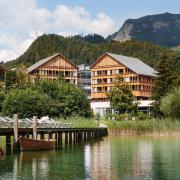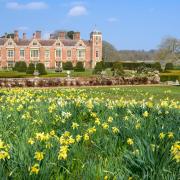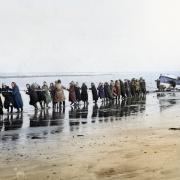The Lord of the Rings, The Hobbit and the notoriously tricky The Silmarillion have inspired generations of readers since they were first published.
Twenty years ago, they were turned into blockbuster movies, and soon the earlier sagas of Tolkien's middle earth will be reimagined in the Amazon Prime tv series The Lord of the Rings: The Rings of Power.
Here we discover some of the places in England that inspired Tolkien's Middle Earth.
1. Sarehole and Hobbiton

Tolkien spent some of his youth in Sarehole, and this charming little area not too far from Birmingham inspired one of the most idyllic locations in Middle-Earth, Hobbiton, a small village, The Shire.
Home to Hobbits, a small-statured species who love the simple things in life such as food (one does not simply skip a second breakfast!), drinking ale and parties. One would be most inclined to say that the life of Hobbit is very much something to aspire to. And though they may be small, the Hobbits prove themselves to be the true heroes in Tolkien's most famous books, The Lord of the Rings and The Hobbit.
Years later, Tolkien described Sarehole as 'a kind of lost paradise,' due to it being relatively unscathed by industrialisation when he was a young boy. He also commented that the people of this charming village also inspired his hobbits, so one can imagine small, inconsequential dramas unfolding that were adapted into the witty feud between the Bagginses and the Sackville Bagginses in the first chapters of his books.
The Sarehole Mill (now a museum) was a key structure e that inspired young Tolkien, and now you can take a guided walk around the area that explores all the different places that captured the future writer's imagination.
2. St Edward's Church and the Doors of Durin
'Speak friend and enter' is the magic inscription that tells the fellowship how to open the magical west gate to the mines of Moria in The Lord of the Rings. But did you know that this famous entrance that Tolkien illustrated in his book could actually be inspired by a real-life place in the Cotswolds?
Tolkien was a Professor of Anglo-Saxon literature at Oxford and was said to have visited Stow-On-The-Wold in Gloucestershire on several occasions. Perhaps due to him being a devout man of the Catholic faith, he may indeed have happened upon the gorgeous church door of St Edward's Church on one of his visits to the area!
3. Roos in Yorkshire and the meeting of Beren and Lúthien

And perhaps the most romantic thing of all is that the gravestone of J.R.R. Tolkien and Edith Tolkien in Oxford is inscribed with the names of Beren and Lúthien because their real-life relationship and deep connection inspired the magical one.
4. The Bell Inn and The Prancing Pony

The Prancing Pony is perhaps the most famous pub in Middle-earth. It is situated in the town of Bree and is where the four adventurous Hobbits (Frodo, Samwise, Merry and Pippin) meet the mysterious ranger known to the locals as Strider.
Real-world inspiration for the inn comes from The Bell Inn in Moreton-in-Marsh, a place the Oxford-based Tolkien would frequent to meet up with his brother, who lived in London. A blue plaque was placed outside the inn by a local group of The Tolkien Society to commemorate the pub's link to Tolkien and the Lord of the Rings.
5. Perrot's Folly and the Edgbaston Waterworks tower and The Two Towers

The second volume of Tolkien's The Lord of the Rings is simply titled The Two Towers; however, figuring out which towers this is in reference to is somewhat less straightforward.
One of the towers is Orthanc in Isengard, the home of the corrupted wizard Saruman, but where things get complicated is in reference to the second tower. Most would be inclined to say that it is clearly Barad-dûr, the dark Lord Sauron's fortress, but Tolkien himself wrote in a letter before publication in 1954 that the second tower is at Cirith Ungol, where Sam has to rescue a captured Frodo.

However, to add to this confusion, in an edition of The Fellowship of the Ring, Tolkien wrote that the second tower is 'the fortress of Minas Morgul that guards the secret entrance to Mordor' and when you take into account the original front cover sketch for the second book it feels more likely that Minas Morgul is the actual second tower.
Luckily, figuring out which structures may have inspired the two towers (whichever they may be!) is actually really straightforward. When Tolkien lived on the outskirts of Birmingham in Edgbaston, there were two rather large and looming towers, Perrot's Folly and a Waterworks tower at the Edgbaston Pumping Station.
6. Bag End Farm and Bag End
The cosy abode of Bilbo Baggins, which was famously described in the first lines of The Hobbit, takes its name directly from Bag End Farm, which was owned by Tolkien's aunt Jane Neave. It is said that Tolkien spent some time at Bag End Farm in 1923 while recovering from an illness, and its perhaps during this stay that he decided upon the name of his hero's home.
7. Cheddar Gorge and the glittering caves of Helm's Deep

The dwarf Gimli spends some time in the glittering caves during the Battle of the Hornburg at a mountainside fortress in the Valley of Helm's deep. He speaks fondly of its unparalleled beauty and proclaims them to be one of the marvels of the northern world. After the War of the Ring, Gimli brings Legolas to see the caves, and in an unexpected twist, the Elf is rendered speechless by their beauty; it's no surprise that soon, a Dwarven colony from Erebor led by Gimli settles there.
In a letter to an S.J. Rourke in 1971, Tolkien admitted that the glittering caves of Helm's Deep were indeed inspired by the wonderful caverns of Cheddar Gorge, somewhere that he had visited in 1940 just before he wrote the passages on them, but he noted that their description was more so 'coloured by my memory of them much earlier [...] I had been there during my honeymoon nearly thirty years before.'
It's easy to see why the Cheddar Gorge would have inspired such a magical place as they themselves are rather enchanting and almost feel like they are a whole other world in of themselves.
8. Lydney Park and Celebrimbor, the Elven forger of the rings of power

In 1929 Tolkien was invited to translate and investigate a Latin inscription found on an archaeological dig at Dwarf's Hill in Lydney Park, Gloucestershire. In the ancient inscription, Tolkien discovered references to a healing God called Nodens, which links to an Irish hero Nuada Airgetlám which means "Nuada of the Silver-Hand", and mentionings of a cursed ring! Therefore, it could be argued that these roman ruins quite likely sparked something major in Tolkien's imagination.
For example, it seems almost definite that Nuada Airgetlám is the inspiration behind Elven smith Celebrimbor's name, which means 'Silver Hand' in Sindarin (Tolkien's language of the Elves); the character appears in The Silmarillion and is perhaps one of the most important figures in the history of Middle Earth.
Celebrimbor is the forger of the rings of power; under the tutelage of Annatar, he and the Dwarf Narvi created 9 rings for men, 7 rings for the dwarves and 3 for the elves, only to find out later that they had been deceived and that a singular ring was forged in the fires of Mount Doom that had the power to control all other rings!
Talking of the ring, interestingly, the cursed ring mentioned at Lydney Park is the Ring of Silvanus, which was discovered in a field near Silchester in Hampshire in 1785.
Silvanus, the owner of the ring, believed it was stolen by a man called Senicianus, and so he went to the temple of Nodens to place a curse on the thief. The parallels between Silvanus and Gollum cursing the name of the rings thief Senicianus and Baggins is hard to miss.
The Ring of Silvanus is now part of the National Trust collection at the Vyne Estate just outside of Basingstoke in Hampshire.
9. Hurst Green in the Ribble Valley and The Shire and beyond

Tolkien visited Stonyhurst College in Hurst Green many times between 1942 and 1947, which is evident through a visitor's book bearing his name on numerous occasions and a sketch of New Lodge, the property he would stay at.
It is said that during his visit to the beautiful Ribble Valley, Tolkien was working on The Lord of the Rings and would also take walks with his son. It is quite likely that the writer encountered several things along his way that may have inspired him.
Examples include the ferry at Hacking Boat House (operational during Tolkien's visits), which is perhaps the inspiration behind the Buckleberry Ferry that the Hobbits use to escape the Nazgûl or ringwraiths hunting them down.
There's also Shire Lane, woodlands that may have inspired the home of Tom Bombadil and Pendle Hill. With its rumours of witches and other dark entities, this imposing hill could have inspired the Barrow-downs, a mysterious location haunted by fearsome Barrow-wights that capture the Hobbits before Bombadil saves them in The Fellowship of the Ring.
As these events all take place close to each other, it would be rather extraordinary if the gorgeous landscape of Hurst Green in the Ribble Valley did indeed inspire this part of the adventure in The Lord of The Rings. Explore the Tolkien Trail here.
Amazon Prime's The Lord of the Rings: The Rings of Power will air on 2nd September 2022, which is the 49th anniversary of J.R.R. Tolkien's death.
Do you think these locations inspired the people, places and legends of Middle Earth? Let us know in the comments section what you think.
Follow Great British Life on Facebook, Twitter and Instagram
Read more of the best Tolkien content on Great British Life here:
How J.R.R. Tolkien escaped unwanted fame on the Bournemouth coast
The perfect short break in Lancashire for Lord of the Rings fans
Dartmoor's Oscar-winning artist Alan Lee on why he loves the area



























